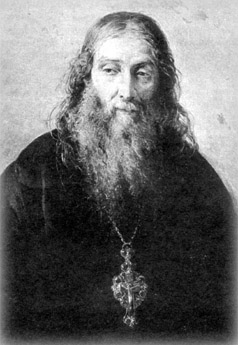
|
 |
The Church of St. Peter the Apostle and the Righteous Tabitha in the Russian site in Jaffa
Among the sites that were once acquired in the Holy Land by Archimandrite Antonin (Kapustin), one of the most important in the history of the Russian spiritual presence in the Holy Land was the site in Jaffa.
Archimandrite Antonin (Kapustin)
Head of the Russian Ecclesiastical Mission in Jerusalem
A brief history of Jaffa before the Russian spiritual presence
The port city of Jaffa - one of the oldest cities in the world, associated with the name of Noah's son Japheth (Japhet) "It will spread" - this is the literal translation of the name Japhet. According to legend, Japheth after the Flood re-established this city, known in the Bible under the Greek name Joppa. Another version of the origin of the city name from the Hebrew word "yafe" is beautiful).
View of Jaffa from the sea.
Collection of photographs of the Imperial Orthodox Palestine Society 1885-1917.
in the State Museum of the History of Religion, St. Petersburg
Another prophet Jonah sails on a ship from Jaffa to Tarshish (Tarshish), breaking the command of God to go preaching to Nivhenia (Iona,3). On the coast of Jaffa, the unlucky Jonah returned from the womb of Leviathan. Lebanese cedars for the construction of the Solomon's Temple arrived in the same port.
The history of this biblical city, which has seen many conquerors over the millennia of its existence, is dramatic and interesting.
Since the XV century BC. Several centuries the city was dominated by the Egyptians, who in 1200 BC, were expelled from there by the Philistines. Joshua tried to discourage Jaffa from the Philistines, but he could not, and only the land around her was given to put on the tribe of Dan. (Today the whole territory is called Gush-Dan).
Jaffa alternately owned: Egypt, Babylon, Persia and the Kingdom of Sidonia. By 332 BC. The city was conquered by Alexander the Great, expanding his empire and conquering more and more new nations.
During the Jewish uprising of the Maccabees (167 BC), directed against the oppression of the largest Hellenistic kingdom of the Seleucids, the inhabitants of Yaffa of non-Jewish origin decided to get rid of the Jews. They cunningly lured them to the ship and drowned them in the sea. The furious Judas Maccabee, the leader of the popular uprising in Judea, attacked the city, burned the port and ships, but he could not take the city. Only later, in 169, Jaffa was seized by the followers of Judas Maccabee, and she began to relate to the Jewish kingdom. When the Maccabees expands port, the city is surrounded by a new wall with towers, coins with an anchor image are minted.
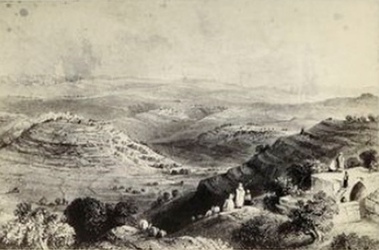 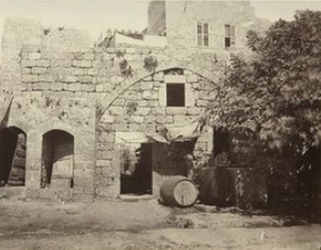
Simon's tanner's house (St. Peter's House).
Collection of photographs of the Imperial Orthodox Palestine Society 1885-1917.
in the State Museum of the History of Religion, St. Petersburg
At the time of the Jesus Christ, the city of Jaffa was a prosperous city with a mixed population. Here he lived for some time in the house of Simon the tanner the St. apostle Peter. Here the apostle Peter had a vision: "... coming down to him some vessel ... In it were all four-footed terrestrial ... And there was a voice to him: get up, Peter, kill and eat" (Acts 10: 11-13) In Jaffa also he performed the miracle of the resurrection of the righteous Tabitha, who: "... was full of good works and did many alms."
Then the Jewish sailors from Jaffa took part in the fighting against the Romans during the Jewish War of 66-73 AD or the Great Uprising against the Romans. The Jews of Jaffa, wishing to support the rebels, sent their ships against Vespasian. After the suppression of the uprising, the Romans declare the city a free city of Flavius Joppa.
Under the Arab conquerors who conquered Palestine for a decade from 630 to 640, the Jaffa port acquired special significance because of the proximity to their capital Ramle [1]. The Arab historian al-Maqdisi wrote: "Jaffa is a small town, but its port is like a shield for Ramla. The walls of the port are strong, no missile cannon can penetrate them, and the city gates and port gates are iron. "
In the XII century, the crusaders came here and created the county of Jaffa-Ashkelon. The crusaders turned Jaffa into their important transit point, built a church in honor of the apostle Peter. They were beaten out by the Mamluks [2], who in 1268 cut out all Christians and destroyed the city to its foundations. Decline came not only the city, where in its ruins huddled a few residents, but also the port.

Jaffa in 1585. View from the west

Jaffa in 1647
Collection of photographs of the Imperial Orthodox Palestine Society 1885-1917.
in the State Museum of the History of Religion, St. Petersburg
It was only in the second half of the 17th century that the city was rebuilt and Jaffa became the main port through which Christian pilgrims arrived to the Holy Land, which were not stopped by the dangers of such a long journey, since until the 18th century sea pirates operated here and Christian pilgrims were attacked by pirates from the sea and brigands on land. Only with the mediation of France in the XVIII century with pirates managed to reach an agreement on non-aggression on ships arriving in Jaffa.
In 1799, during the Egyptian campaign, Napoleon had to wage heavy fights for Jaffa. The siege was conducted for three days, when it managed to breach the wall, the French soldiers met the desperate resistance of the Turks for each house. The enraged soldiers of Napoleon were killed all in a row. Soon the epidemic of bubonic plague broke out. Napoleon hastily escaped, leaving in the city more than 200 seriously wounded his soldiers.
Jaffa. Mosque
Abu-Nabud (left) and the fountain of Abu-Nabud
Bazaar and jetty in Jaffa.
Collection of photographs of the Imperial Orthodox Palestine Society 1885-1917.
in the State Museum of the History of Religion, St. Petersburg
Only 15 years after this defeat and devastation and in connection with the growing pilgrimage, Jaffa began to rebuild and reborn under Governor Mohammed Abu-Nabud, whose cruelty was legendary ("nabud" in the Arabian word "baton, stick"). With it, the walls were restored, the stone for which was brought from Caesarea and Ashkelon. The gates were reinforced with guns, put guards, opened customs. Abu-Nabud paid special attention to the port. Near the port was built a khan (inn) and several markets. In place of the old one, a new mosque has grown, luxurious fountains have been built. The French and English consulates open.
The formation of the Russian spiritual presence in Jaffa
In 1820, the Russian Vice-Consulate was established in Jaffa - the first Russian diplomatic mission in the Holy Land. After 36 years, the Russian Society for Shipping and Trade appeared, sending ships with pilgrims from Odessa to Athos and to Jaffa at preferential prices.
Ships and carriers in the harbor of Jaffa.
Collection of photographs of the Imperial Orthodox Palestine Society 1885-1917.
in the State Museum of the History of Religion, St. Petersburg
Because of the pitfalls and rocks of the Jaffa Harbor, steamboats were not able to reach the shore, and pilgrims arriving in Jaffa often fell into the hands of boatmen who shamelessly stuffed their luggage into boats and unceremoniously drove to local hotels where they were paid a fee 2-3 times more than it actually cost.
It is interesting to describe the arrival in Jaffa in his book "Journey to Palestine" Vasily Khitrovo, future secretary, ideologue and inspirer of the Imperial Orthodox Palestine Society, who visited the Holy Land in the summer of 1871:
"Arriving ship stops, in the case of a calm sea, about 2, 3, and even 5 from the shore, in case of a storm, it does not stop at all, but rather moves away from the coast. There is no protection from winds. Then, when the ship or ship dropped its anchor, you are given a boat to get to the land. But among these sites, Jaffa is considered even more dangerous than others. In Verst from the coast there is a submarine ridge of stones, the remainder of the rocky bottom carved by the age-old sea surf is unknown. Among this submarine ridge there is a space of two or three sazhens of breadth, in this gate it is necessary to get to those who wish to dryly make their way to Jaffa. Approaching them, the boatmen are suspended, waiting for the waves and on the ridge it moves a dangerous place, a few fathoms to the right and left and you fall on the rocks, the boat turns over and you have to take a sea bath. However, it should be noted that the practice of several centuries has so marked the experience of the Jaffa boatmen that it does not happen to get into this gate very rarely, not to say - never.
When the passage in the case of a storm is not possible, even for the most experienced boatman, the ships do not stop and you, who wants to land in Jaffa, have to either Kaifa or Port Said in order to return from there again, counting on more favorable weather. As there were no storms, we, as probably millions of fans of all times and centuries, waited for the wave, cleverly made their way across the stony ridge, and in a few minutes found themselves at a few high-heaped stones bearing the loud name of the Jaffa wharf. Someone gave a hand over, someone planted from the bottom and thus early on the morning of July 12 we found ourselves on the shores of Palestine.
Half-naked, nigger boys picked up our travel bags, from the next window shouted something, some sir in the fez, who turned out to be a customs inspector, someone shouted the "baksheesh" inevitable in the east, and we followed the Kavas along the streets The Jaffa. Along the streets, I say, as applied to European concepts, because in reality it is impossible to call that long, narrow, angular, rising and falling corridor along which we walked, and which was even more like a corridor, in view of total absence, in the majority eastern cities, including in Jaffa, windows on the street "[3].
No less interesting description of the arrival in the Jaffa port and the first impressions of visiting the ancient city is given by the pilgrim Sergey Mech in 1895:
"The ship approaches the city of Jaffa. This city is similar to a pile of houses that are closely joined to each other. It is impossible to approach the ship by Jaffe; in front of the city, in the sea, there is a ridge of reefs, and waves with noise are broken about it. Therefore, the ship becomes anchored for a whole mile from the shore, and it is necessary to sail to Jaffa in a boat.
Hardly had our ship dropped anchor and stopped, as it is surrounded by hundreds of boats, where tanned, swarthy Arabs are sitting.
They, like the cab drivers, want to find a passenger to take him ashore and get a payment. All of them rush to the steamer. Black, brown, gray, swarthy and white faces climb each other along the ladder of the steamboat (along the ladder), fists angrily flutter through the air, faces are distorted by anger, everyone screams, scolds, wags their hands, overturns each other. The hanging ladder of the gangway is cracking from this frenzied pressure and, it seems, is just about to zagromit down with all this clinging to her crowd. Suitcases of passengers are snatched up by impudent hands, without demand and bargaining, frantically dragging to the side and flopping down from there, to swinging boats. The Arabs, having mastered the belongings, are quite sure that the passengers will find them and willy-nilly they will find themselves in their boats. But the most daring are not satisfied with their belongings, they also grab the passengers themselves unceremoniously and forcibly drag them into their boats.
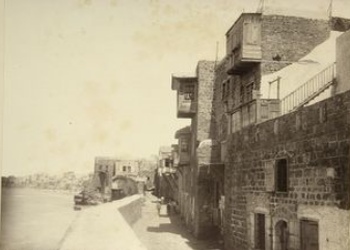 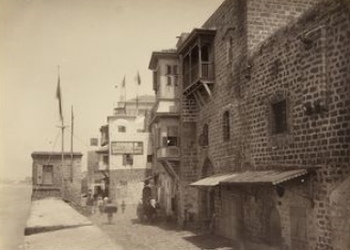
City streets on the waterfront of Jaffa.
Collection of photographs of the Imperial Orthodox Palestine Society 1885-1917.
in the State Museum of the History of Religion, St. Petersburg
But here we are on the waterfront of Jaffa. This embankment is narrow, cramped, poorly paved and so cluttered forever by the people, donkeys and camels that it is difficult to get through, especially on the days of the arrival of the steamers. When the Russian pilgrim lands on this embankment, when he feels the firm earth under him, then at that moment he forgets everything. Without hearing the din and noise of the crowd clinging to the embankment, he does not hesitate to openly express the feelings that fill his heart - he falls down and kisses the sacred ground.
Jaffa.
Collection of photographs of the Imperial Orthodox Palestine Society 1885-1917.
in the State Museum of the History of Religion, St. Petersburg
Jaffa is beautiful only from afar, but when you climb into it, now you see that this is a bad town. The streets are dark, narrow, dirty, sometimes they go uphill in steps, so that it's like walking down the bell tower of Ivan the Great. Traveling on them on a hot day and even with luggage is very hard. And the sun in Palestine does not warm our way. Palestine is located in warm regions where winters never happen, and where the sun burns through a person.
What is good in Jaffa is not the city, but the gardens that surround it in a semicircle about eight versts. All over the world, I think, there are few such luxurious gardens. These are whole forests of orange trees, and they are mixed with apricots, peaches, almonds.
Every year hundreds of thousands of oranges are transported from Jaffa to our countries. In February orange trees start to blossom, and then, swam up to the steamer in Jaffa, you can hear for 2 versts a wonderful smell of these flowers.
Since there is almost no rain in Jaffa all summer long - it goes there only in December, January and February - then the Jaffa gardens should be watered so that they do not wither. But the fact is that there is not a single stream around Jaffa. Therefore, there is a well dug in every garden, from which they draw water all day and pour in gardens.
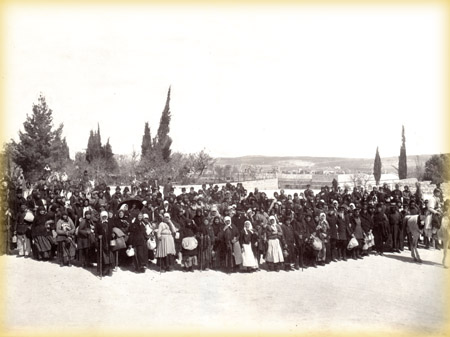
A caravan of pilgrims is ready to depart from Jaffa to Jerusalem.
Photo from the archive of the Jerusalem branch of the IOPS
The distance from Jaffa to Jerusalem is the same as that between Moscow and Trinity-Cepegiy Lavra, that is, about 70 versts (about 74 kilometers - note by Pavel Platonov). A good highway and a railway connect these two cities ... But it is best to walk, taking a wand in hand, and throwing a bag with the most necessary good.
Across? the road goes out of the Jaffa gardens and winds along a flat spot, between fields, fields and villages. Walking along this road, we will see a lot of curious. The ancient half-ruined wells huddle in greenery, and beside them the crowds of women in the same clothes, with the same jugs as were during Rachel and Laban; huge Arabs wait on tiny donkeys; flocks of sheep await their turn to get drunk at the well; the shepherds play the flute; women go with fruit to the market in Jaffa; Arabs on camels, on horses, on donkeys. And in the distance the Judah mountains turn blue, on which Abraham and Noah looked "[4].
By the end of the sixties of the nineteenth century it became evident that one had to have his own compound for Russian pilgrims in Jaffa or its environs, and the head of the Russian ecclesiastical mission in Jerusalem, Archimandrite Antonin (Kapustin), thanks to his personal initiative, as in the cases with other Russian sites in the Holy Land, has practically carried out this good deed.
The Church of St. Apostle Peter and righteous Tabitha in the Russian site in Jaffa
In 1868 Archimandrite Antonin purchased a plot of land in the vicinity of Jaffa, called "Darbatein Tabitha - (Two lanes of Tabitha) [5]" - (orchard) [6]. This place was known to Russian pilgrims who had long ago gone out for prayer to a large wasteland, next to the Jewish graves. The site belonged to two owners and in the acquisition of his father Antonin helped Jacob Halebi - longtime assistant of Archimandrite Antonin. The site was designed in the name of Jakob Halebi on August 18, 1868 [7].
Franciscan hospice house in Jaffa
Jaffa. View of the German colony.
Collection of photographs of the Imperial Orthodox Palestine Society 1885-1917.
in the State Museum of the History of Religion, St. Petersburg
But St. Petersburg authorities, in the person of the Asian Department of the Ministry of Foreign Affairs, and also the Synod, treated the purchase of lands by Archimandrite Antonin as unfriendly. Acquisitions of Archimandrite Antonin (Kapustin) went against the state policy of Russia at that time - "maintaining the status quo over holy places". The absurdity of the situation was that at the same time, Catholics and Protestants acquired everything that was possible without worrying about whether they were leaving diplomatic borders. This attitude of the capital, of course, caused a fair indignation and surprise father Antonin. The strange situation turned out, all confession bought land in Palestine, and Russia, which sought to protect Orthodoxy and strengthen its positions, was negative about this because of some dubious diplomatic concerns. [8]
The house, built by Antonin (Kapustin) on the Russian site in Jaffa,
Used as a shelter for pilgrims.
Photo archive of the Society "Russia in Colors"
Jaffa. Russian house in the garden of St.Tavifa.
Collection of photographs of the Imperial Orthodox Palestine Society 1885-1917.
in the State Museum of the History of Religion, St. Petersburg
Photo archive of the Society "Russia in Colors"
Whatever it was, some time after the purchase, on the site appeared farm buildings, a house that was used as a pilgrimage shelter, and where he loved to visit father Antonin (Kapustin), dug a pool and a well for water. Also fruit trees (oranges, lemons, olives, pomegranates, figs) and ornamental (cypress, eucalyptus, pine) trees were planted. The size of the land bought in Jaffa was 33.750 sq.m., the price was 2.800 francs [9]. On the south side, a small plot of 180 francs was bought.
The Crypt of St. Tabitha.
Collection of photographs of the Imperial Orthodox Palestine Society 1885-1917.
in the State Museum of the History of Religion, St. Petersburg
Chapel on the tomb of the rights. Tabitha,
equipped yet Archimandrite Antonin (Kapustin)
Photo archive of the Society "Russia in Colors"
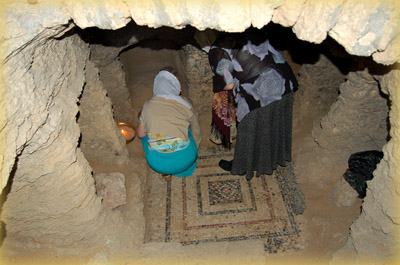
Russian pilgrims in the tomb of St. Tavifa.
The mosaic floor was preserved from the Byzantine period.
Photo archive of the Society "Russia in Colors"
It is this site that the local tradition associated with the place of rest of St. Tavith's right. Archimandrite Antonin, with the help of the Jerusalem architect Konrad Schick [10], found a place in the garden where, during excavations, a tomb of the righteous with a well-preserved mosaic of the Byzantine era of the 5th-6th centuries was discovered.
The appearance of a Russian site in Jaffa was of great importance for Russian pilgrims of that time. Now, admirers arriving to holy places could use the Russian cellar, where they received everything they needed at symbolic prices, where they were met in their native language. This fact is noted in the memoirs of Vasily Nikolaevich Khitrovo "Journey to Palestine".
"A few turns to the right and left, a few sprouts up, down the slopes and we are at the house, with a cross carved in the wall. The door opened, the courtyard surrounded by rooms, the outer staircase upstairs, another courtyard that turned out to be a flat roof of the lower buildings, several doors from the rooms opening onto it. Welcome, you are in the Jaffa Russian compound.
But even if he did not speak Russian with a broken Russian language, an Arab housekeeper, this samovar standing in the doorway of a mantis in a black dress and headscarf, this samovar, which was seen on the table in another room, was reminiscent of the familiar pictures of a distant homeland". [11].
Here is how the Russian site in Jaffa was described in the Act on the Establishment of the Waqf [12] by Archimandrite Antonin (Kapustin) of September 12, 1889:
«<6> Jaffa
The entire site, known as the Darbatain Tabitha (Two Tawifa Lane), outside of Jaffa, part of its southern lands, is located among the ruins of a public pond called Sebil al-Shifa, consisting of a courtyard and a garden. In the yard there are: a well, a reservoir, a Finde (a special expression of Jaffa gardeners, meaning a wooden structure that supports the wheel of a well), an iron wheel, a house (two rooms and a corridor in the lower floor and four rooms and a corridor in the three adjacent to the house rooms on the south side, with a separate entrance, a large stable and a room intended for storing straw and barley adjacent to the mentioned house on the east side, three adjoining rooms in the aforementioned stables on the east side, a large room with walls of wood and brick, located between the reservoir and the well, a kitchen opposite the three rooms on the north side. In the garden there are various trees, mechanisms for watering trees, a fence of living cacti that surrounds the garden on four sides.
Borders:
The boundaries of the described "baiar" (garden) with all its buildings are as follows: in the south there is a country road through which two gates lead to the garden and the dwellings of Negroes. In the east - the garden of Jiries Dabbas, the Orthodox. To the north is the vineyard of the shelter of our lord, a friend of God, Shaykh el Bakri, who (the vineyard) is the property of the late Assassin Mansur. In the west is a country road.
Foundation and origin:
The described garden was purchased by the founder of the waqf, which is confirmed by a copy of the hodjet registered in the Shariah court of Jaffa, and the original of the hafset is dated 24 Jemazi-l-Evel 1290, and the copy is sealed with the signature and seal of former Judge Mohammed Reshid al-Attar of Damascus. The construction of buildings and the planting of trees were carried out by him at his own expense.
All rights to the land, roads and facilities of all of the above, as well as what can be added to it, are included in the vakuf, which is established on the basis of original documents and is impeccable in terms of legality, the waqf is impeccable and obligatory for compliance, where the name will never disappear and not a single trait will pass away, but on the contrary, with the passage of time, it will be stronger and stronger and will last for ever and ever, until the Lord, the best of heirs, inherits the earth and everything that is on it " [13].
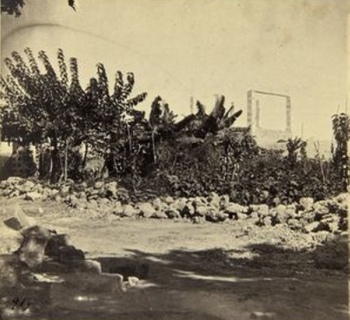 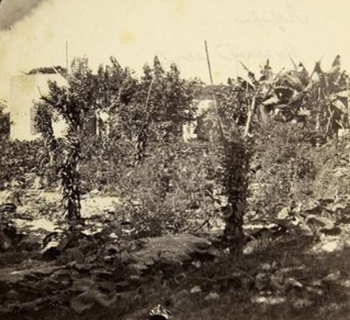
Jaffa. Judgment place.
Collection of photographs of the Imperial Orthodox Palestine Society 1885-1917.
in the State Museum of the History of Religion, St. Petersburg
"Golgotha" (Calvary - note by Pavel Platonov) of Archimandrite Antonin (Kapustin).
Photo archive of the Society "Russia in Colors"
Here the caravans of pilgrims who traveled to Jerusalem through the villages of Ramla and Lidda (Lod - note of Pavel Platonov) [14] and Abu Ghosh, accompanied by guards and representatives of the Russian Ecclesiastical Mission in Jerusalem, and from 1882 and the Imperial Orthodox Palestine Society began to form. Soon all this land on the east side of Jaffa turns into a blooming garden - one of the most beautiful places in the city, and the Jaffa site is considered one of the most comfortable and beautiful possessions of the Russian Ecclesiastical Mission. Archimandrite Antonin (Kapustin) loved this place and often spent time here in the summer months and even built here a "model of Golgotha" (Calvary - note by Pavel Platonov) - a large embankment, repeating the scale and general outlines of the original Golgotha archaeologically reconstructed by the scientist [15].
On March 27, 1884, a large bell weighing 308 poods (weight about five tons - note Pavel Platonov), 2 meters and 13 cm in diameter, donated by the member of the Orthodox Palestine Society Solikamsk merchant Alexander Ryazantsev was brought to Jaffa on the steamship "Kornilov" and intended for the Russian Savior-Ascension church on the Mount of Olives. In August 1884, this bell, thanks to the financial assistance of Countess Olga Putyatina, was transported from the pier to a Russian garden in Jaffa near the grave of St. Tabitha. Further it was to drive to Olive. Our zealous pilgrims dragged him to himself!
The bell, donated by merchant Alexander Ryazantsev,
delivered to the Mount of Olives from Jaffa.
Collection of photographs of the Imperial Orthodox Palestine Society 1885-1917.
in the State Museum of the History of Religion, St. Petersburg
"And," wrote Archimandrite Antoninus, "105 people (two-thirds of a woman) hastily arrived in Jaffa and set to work. Thanks to the general enthusiasm, within 7 days the bell, despite a thousand difficulties, was safely delivered (on hands!) To our buildings. February 5 evening he had an enthusiastic meeting, raising the whole city to his feet. Then the whole mass of pilgrims undertook to drag the bell to St. Eleon, to the place of his appointment "[16].
Of course, Antonin wanted to see the church and on the site in Jaffa. In 1884, correspondence began with St. Petersburg on the construction of a church in the Russian site in Jaffa. Father Antonin starts a business about building a church and tries to get a firman from the Sultan. But, as was usually the case with the construction of other churches in the Holy Land, it gets obstructed by the Turkish authorities. Here is what Archimandrite Antonin wrote in St. Synod of the Russian Orthodox Church on October 28, 1885:
"3) The supposed, at the request of the blessed memory of Earl E.V. Putyatin and other Christ-lovers, in Jaffa-the ancient Joppa-the Russian church has to be erected inside the Jaffa gardens on the purchase of a piece of land I acquired in 1869, which from time immemorial bore the name of St. Tabitha, there, it is necessary to think, buried. The case of this church was entered by me through the intermediary of the Imperial Embassy of ours in Constantinople at the beginning of the last 1884 - on demand it was granted on June 16 of the same year by the Patriarchal consent, allowed, in December of the same year, by the Jaffa Majlis and the local governor, but not yet brought to the end - not authorized by the Sultan firman "[17].
The church in the name of St. Peter the Apostle and righteous Tabitha in Jaffa was laid by Archimandrite Antonin only 3 years after the message of the petition for construction - October 6, 1888 in the presence of Grand Dukes Sergey and Pavel Alexandrovich and Grand Duchess Elizabeth Feodorovna. About the foundation of the church in Jaffa wrote in his diary from October 6, 1888, Archimandrite Antonin (Kapustin):
"... Prepared stones, lime and all the rest. The trebnik (liturgical book - note Pavel Platonov), phelonion, holy water are brought. At 9.00 hours they said: "They are coming!". After greeting them (Grand Duke Sergiy and Pavel and Grand Duchess Elisabeth Feodorovna) I dressed and began to read prayers and litanies so fluently that the attention of the HIGH public did not get tired. The last prayer was read already in the very moat, kneeling, calling the Church of the Saints the first-class apostles PETER and PAUL and St. righteous TABITHA. God bless, in addition to my lawless and sinful hands erected indestructible and eternal monument of the glorious event - the resurrection of the last first of the apostles! Followed by me, both the great PRINCE and the Grand Duchess put their own lime on the main stone with a shovel of lime, and several coins, including the golden semi-imperial of the current 1888, were also made into the hollowed-out cavity in it, also the faces of their suite of HIGHEST. Then, when singing the troparion: "Save Thy Lord thy people ..." covered the stone with another and immediately forgot the place ... I, having exposed, thanked the august witnesses and participants of the bookmark, wished every blessing from the soil of the earth, and from the dew of the heavens, including the long life of numerous offspring, to glory and adornment of the Orthodox Church. Amen. "[18].
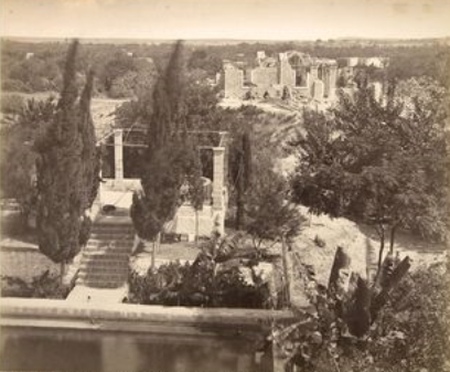
Construction of the church in the garden of St. Tabitha in Jaffa.
The picture was taken on August 4, 1889.
Collection of photographs of the Imperial Orthodox Palestine Society 1885-1917.
in the State Museum of the History of Religion, St. Petersburg
The construction of the church was assisted by Italian masters [19] and local residents [20], the artist A.Z. Ledakov wrote free icons in 1889, but due to lack of funds construction was delayed.
The white iconostasis of the church was donated in honor of the 50th anniversary of the scholarly activity of Archimandrite Antonin (Kapustin) and to the 25th anniversary of his service in the Holy Land from the Imperial Orthodox Palestine Society [21], as evidenced by the signs of the Society at the bottom of the iconostasis and the letter of M.P Stepanov to the head of the Russian Ecclesiastical Mission in Jerusalem, Archimandrite Antonin (Kapustin):
"Your Reverence,
Dear farther Antonin,
The iconostasis for the church under construction in the house of St. The Tabitha in Jaffa, which you favorably received as a presentation of the Imperial Orthodox Palestine Society in memory of your 25-year stay in Holy City, is over and today sent to Jaffa in the name of Vl.N. Timofeev [22] to transfer it to you.
The following icons, which are painted by the artist A.Z. Ledakov [23], will also be delivered to you in Jaffa as they are prepared.
Asking for your blessing and entrusting yourself to the intercession of your prayers,
I remain sincerely devoted to you and heartily respecting, etc. "[24] .
Construction of the church in Jaffa.
Collection of photographs of the Imperial Orthodox Palestine Society 1885-1917.
in the State Museum of the History of Religion, St. Petersburg
Eight months later, on December 3, 1891, M.P. Stepanov wrote another letter to Father Antonin:
"Your Reverence, Dear Archimandrite Father,
1. Your venerable letter of October 24 this year. I was sincerely pleased to receive and hasten to inform you that, in accordance with the desire expressed by you, the Society Council decided to ask you not to refuse to take on behalf of the Company 200 ser. On the church you build in Jaffa. About the transfer of the gift you are notified N.Gr.Mikhailov. The current bad harvest year should strongly affect the income of the Society, which I ask you to take into consideration with the relative scarcity of our donation "[25].
Unfortunately, the architect of the project is unknown. Russian scientist-Palestinian N.N. Lisovoi assumes that the architectural solution is closer to the Holy Trinity Cathedral of the Russian Ecclesiastical Mission in Jerusalem by the architect Martin Eppinger. It is also possible to assume by the nature of the construction of the church and the bell tower that in their construction as architects Italian architects Antonino Langodorno and Baptista Biseli, who helped Father Antonin in the construction of the church on Mount Eleon in Jerusalem, could participate. There is a stylistic similarity between the churches on the top of the Mount of Olives in Jerusalem and in Jaffa. In any case, obviously the Italian influence on the Russian church in Jaffa.
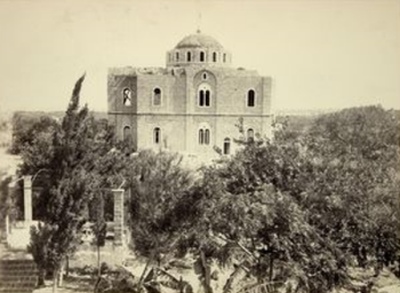
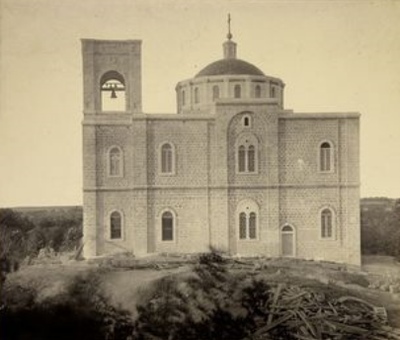
Stages of the construction of the church in Jaffa.
Collection of photographs of the Imperial Orthodox Palestine Society 1885-1917.
in the State Museum of the History of Religion, St. Petersburg
The church was consecrated on January 16, 1894, by the Patriarch of Jerusalem, Gerasimos, in collaboration with Metropolitan Peter of Arabia and Archbishop of Jordan, and Archimandrite Antonin (Kapustin).
The belfry of the church, consecrated in the name. St. Peter and righteous Tabitha, is the highest point of Jaffa and is visible from all sides. "The very high church bell tower is visible far from the sea, and also from the railroad train" [26]. The construction of the bell tower of the Jaffa Church at the time of its consecration was not yet complete. In his Spiritual Testament, dictated to the Russian Imperial Russian Consul General in Jerusalem by Sergei Vasilievich Arseniev, on March 19, 1894, Archimandrite Antonin (Kapustin) gave special instructions on the Jaffa Church:
"6.) The monetary sums in the hands of the Odessa authorized representative of the Palestinian Society, Mikhail Ivanovich Osipov, according to his last statement, are in the amount of five thousand six hundred and ninety one rubles nine kopecks. He made orders for this amount, the lattice for the balconies of the bell tower of the Russian church in Jaffa, the pyramid and the cross with an apple for the same bell tower and lightning rod. All that is required for the end of the Jaffa Church, I will be willing to take out of this sum, referring to orders to Mr. Osipov.
...
9.) The amount mentioned in the sixth paragraph, which is in the hands of G. Osipov, may be all wasted, if necessary, at the end of the calculations for the construction of the Jaffa church and the house under construction "[27].
The Jaffa site, due to the variety and abundance of fruit trees on it, brought an annual income that practically covers all the annual expenses for its maintenance, which could not be said about the sites of the Russian Ecclesiastical Mission in Jericho, on Eleon and in Gorny:
"I. The estate near Jaffa
Income per year
4.000 francs, derived mainly from the sale of oranges and small green lemons. The first collect about 120,000 pieces and sell for 35-40 francs per thousand Jaffa accounts, which contains 1,500 pieces, that is, for the amount of 2,800-3,200 francs. The second is about 12.000 - for the amount of 200-240 francs.
Small incomes - 600 francs.
Expenses per year
1) The total content of four mules and two donkeys ........................ .1800 fr.
2) The chief gardener 1/6 of the income, which is sometimes ... 700 fr.
3) For the burrowing of trees ............................................................ 400-500 fr.
4) For manure .................................................................................... 150-200 fr.
5) The guardian before ............................................................................. .150 fr.
6) The general supervisor of the garden is not less than .................................... ..300 fr.
7) The caretaker behind the shelter of the worshiper .............................. 550 fr.
8) Amendments to the household ................................................................ 200 fr.
9) Payment of verga [28] and for schools of the Turkish Government for the soil for revaluation of 1305 (1889) - 280 piasters, ie ... .. 53 francs
Total: 4.420-4.570 fr.
When Father Antonin bought this estate in 1868, it represented a bare rocky place. He paid 2.800 francs for it. Turkish power in 1305 (1889), the soil and trees were estimated at 50,000 piastres, ie 11.250 francs, and the buildings (the church did not enter into the assessment) in the amount of 26,000 piastres, that is, 5.850 francs.
In fact, at this time, houses can be valued at 50,000 francs; and all the rest - 150,000 francs, except the church, which spent a little more than 60,000 francs "[29].
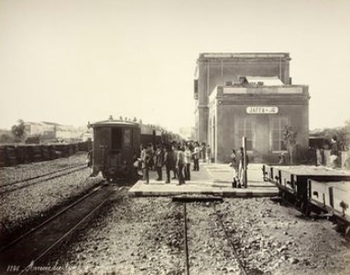 
Railway station in Jaffa.
Collection of photographs of the Imperial Orthodox Palestine Society 1885-1917.
in the State Museum of the History of Religion, St. Petersburg
With the opening of the railway in 1892, the issue of placing fans until the departure of the caravan from Jaffa to Jerusalem goes to the past. "You can get to Jerusalem in many ways. You can go by rail, as most of the worshipers now do; you can ride a horse; you can ride on a donkey; you can go in a German van. But it is best to walk, taking a wand in his hand, and throwing a knapsack with the most necessary goods by the shoulders "[30]. About one in the afternoon the pilgrims departed the Jaffa-Jerusalem railway on an extremely slow moving train, which, despite the insignificant distance, only 82 miles, was on the road for 6 hours, making an hour no more than 15 miles [31].
Since the steamships arrived at the port of Jaffa in the early morning and the train left for Jerusalem for a considerable time, pilgrims, accompanied by the Kawas of the Imperial Orthodox Palestine Society, visited either the St. George's Monastery on the shore of the sea or the house and orchard belonging to the Russian Spiritual Mission with the Church of St. ap. Peter and right. Tabitha. In both Greek and Russian monasteries, pilgrims received a warm welcome. The same happened while waiting for the ship to sail [32].
Church in the name of St. Peter and righteous Tabitha in Jaffa.
Photo archive of the Society "Russia in Colors"
Here is a description of the Russian church in Jaffa that gives a report on the revision of the monetary and material economy and on the review of real estate, accounting and reporting of the Russian Ecclesiastical Mission in Jerusalem on November 4, 1914:
"The church in the name of St. Apostle Peter, with the side-chapel of Righteous Tabitha, in the Jaffa Compound - a very beautiful architecture and very roomy, with internal choruses, was built by Archimandrite Antonin in the place of St. Tavifa's house. Inside the church is richly decorated with murals from the events of Ap.Peter's life. The iconostasis is multi-level, very good. The church utensils and sacristy in sufficient quantity are rather modest "[33].
The left side-altar dedicated to the righteous Tabitha.
Photo archive of the Society "Russia in Colors"
The central altar is dedicated to the apostles Peter.
The iconostasis, presented by the Imperial Orthodox Palestine Society to father Antonin (Kapustin)
Photo archive of the Society "Russia in Colors"
Famous Russian researcher of the Holy Land N.N. Lisovoi gives a detailed description of the church inside:
"There are two altars in the church. The left is dedicated to Tabitha, the central one to the "honest beliefs of the apostle Peter" (that is, to the remembrance of his miraculous release from prison ties). The white iconostasis of the church is a gift to father Antonin from the Imperial Orthodox Palestine Society for the 50th anniversary of his scientific work. The iconostasis is two-tiered. Eight elegant columns with gilded capitals in the first tier, as much smaller size - in the second tier. In the local row, to the left of the Mother of God, according to the church canon, the main, patronal image is "The Resurrection of Tabitha."
Wall paintings were made at one of the successors of Antonin (Kapustin) - Archimandrite Leonid (Sentsov) in 1905. According the lokal tradition, the craftsmen from Pochaev Lavra worked here. On the walls of the church, as in the upper tier, on the choirs, scenes from the life of the apostle Peter are presented. On the altar pillars separating the altar and the deacon from the altar, Peter and Paul are depicted. On the remaining pillars, in the upper part of them, at the level of the choirs, there are ten other of the Twelve Apostles. Now that the paintings are beautifully restored, one can believe the memoirists that the architectural significance and artistry of the interior made the Russian temple at the beginning of this century one of the outstanding sights of ancient Jaffa "[34].
Unfortunately, the construction of the temple on the Jaffa site was the last feat of Father Antonin, falling ill, it is believed, even during the consecration of the church in Jaffa, two months later on the eve of the Annunciation on March 24, 1894, he departs to the Lord, and the Russian bell on the mount of Olive ushered in this loss - the death of the collector of Russian Palestine [35].
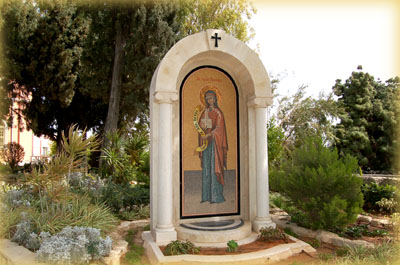
Mosaic icon of St. Tabitha in a Russian site in Jaffa
Photo archive of the Society "Russia in Colors"
Russian Orthodox pilgrims from St. Petersburg on a Russian site in Jaffa
Photo archive of the Society "Russia in Colors"
Today this site in Jaffa is in the jurisdiction of the Russian Orthodox Church of the Moscow Patriarchate, it is put in order and decorated in many ways by the efforts of members of the Russian ecclesiastical mission and parishioners. The church and bell tower were renovated in 1997 to the 150th anniversary of the RDM. The restoration of wall paintings was carried out. Orthodox pilgrims who come to the Holy Land from different parts of Russia and abroad, with joy and reverence visit this picturesque Russian corner in the Holy Land with the church of St. Apostle Peter and righteous Tabitha, honoring the memory of the outstanding figure of Orthodoxy, Archimandrite Antonin (Kapustin).
Chairman of the Jerusalem Branch
Of the Imperial Orthodox Palestine Society
[1]. The only city in the Holy Land, founded by the Arabs.
[2]. Mamluk. Mamluks (Arab - white slaves, slaves), slave warriors (from the Turks, as well as Georgians, Circassians and other Caucasian peoples in Egypt), from which the Guards of the rulers of the dynasty Ayyubid (1171-1250) were formed. TSB.
[3]. V.N. Khitrovo. "A week in Palestine From travel memories." St. Petersburg. 1879 Edition 2-nd. page 5-6
[4]. Sergey Mech. "Trip to Palestine". (Geographical sketch). 1895
[5]. Russia in the Holy Land. Documents and materials. Volume II. 61. The Act on the Establishment of the Waqf by Archimandrite Antonin. September 12, 1889 page 218. Jaffa .. Moscow. "International relationships". 2000. The Foreign Policy Archive of the Russian Empire of the Russian Ministry of Foreign Affairs, IOPS, Institute of Russian History of the Russian Academy of Sciences.
[6]. Russia in the Holy Land. Documents and materials. Volume I. 17. Inventory of all Russian real estate in Palestine and Syria, with the exception of private ownership, an appendix to the report of AG Yakovlev to the ambassador in Constantinople to AI Nelidov. p. 98. Moscow. "International relationships". 2000. The Foreign Policy Archive of the Russian Empire of the Russian Ministry of Foreign Affairs, IOPS, Institute of Russian History of the Russian Academy of Sciences.
[7]. Olga Zerpitskaya. Archimandrite Antonin (Kapustin) and Russian shrines in the Holy Land. Journal of St. Petersburg diocesan lists. 2000 No. 21-22
[8]. Archimandrite Cyprian (Kern). Archimandrite Cyprian (Kern). O. Antonin Kapustin Archimandrite and Head of the Russian Ecclesiastical Mission in Jerusalem. Chapter VIII. The Jerusalem years. Стр. 179
[9]. Archimandrite Nicodim (Rotov). "History of the Russian Ecclesiastical Mission in Jerusalem". Chapter III. Archimandrite Antonin (Kapustin) and the Russian Spiritual Mission under his direction. Стр.255. Edition Serpukhovsky Vysotsky monastery in 1997
[10]. Archimandrite Cyprian (Kern). Archimandrite Cyprian (Kern). O. Antonin Kapustin Archimandrite and Head of the Russian Ecclesiastical Mission in Jerusalem. Chapter VIII. The Jerusalem years. Стр. 179. Publishing house Krutitskogo podvorya. Society of Church History Lovers. Moscow 2005
[11]. V.N. Khitrovo. "A week in Palestine From travel memories." St. Petersburg. 1879 Edition 2-nd. page 5-6
[12]. Vakuf, Arab., In Muslim law, property inalienable, withdrawn from civil circulation. Originally - the lands conquered by the Muslims from the infidels; they were state property, but were left for a certain duty (haraj) in hereditary possession and use of former owners. Then B. naming. property donated to mosques and charitable institutions. Unlike spiritual (legal) V. established private (ordinary) V. in favor of certain genera. The management of private property is in the hands of the clergy for a large remuneration, and revenues go to the benefit of certain individuals. Such V. emerged for the sake of property protection from seizures of mercenary administration in the east. states. In Russia, V. are in the Crimea and in a small number in the Transcaucasus and Turkestan. 1885 in Crimea, a commission was established on the regulation of the Waqf. property. A small encyclopedic dictionary of Brockhaus and Efron.
[13]. "Russia in the Holy Land. Documents and materials ". Volume II. 61. The Act on the Establishment of the Waqf by Archimandrite Antonin. September 12, 1889 page 218. Jaffa .. Moscow. "International relationships". 2000. The Foreign Policy Archive of the Russian Empire of the Russian Ministry of Foreign Affairs, IOPS, Institute of Russian History of the Russian Academy of Sciences.
[14]. Lydda is the modern city of Lod. According to the tradition of the Jerusalem Church, the saint's mother lived here, and here he was buried. Church of St. George the Victorious in Lidda, built in the IV century.
[15]. N.N. Lisovoi. "Come and see. The testimony of God on earth. " Temple of the Apostle Peter and righteous Tabitha in Jaffa. P.241.
[16]. Cit. by Dmitrievsky A. The head of the Russian Ecclesiastical Mission in Jerusalem, Archimandrite Antonin (Kapustin) as an actor for the benefit of Orthodoxy in the East, and in particular in Palestine. (Concerning the Decade of His Death) // IOPS Reports. 1904. Т. XV Вып.2.с. 95-148. SM Dmitrevsky "Russian excavations on the Oliveon." Moscow. 2006 Indrik Publishing House p. 77
[17]. The report of the head of the Russian Ecclesiastical Mission in Jerusalem, Archimandrite Antoninus in St. Synod. October 28, 1885). WUA RI, f. RIPPO, op. 873/11, d., L., 16-17. "Russia in the Holy Land. Documents and materials ". Volume II. 199-200. Moscow. "International relationships". 2000. The Foreign Policy Archive of the Russian Empire of the Russian Ministry of Foreign Affairs, IOPS, Institute of Russian History of the Russian Academy of Sciences.
[18]. From the diary of the arch. Antonina (Kapustina) for September 28-October 6, 1888. Quoted from "Construction of the Church of St. Mary Magdalene on the Mount of Olives in Jerusalem. Стр. 118. Moscow. 2006 Publishing house Indrik.
[19]. Central State Historical Archives of St. Petersburg. f. 834. 1817-1894. op. 1118-1131. No. 4. It is quoted from the above-mentioned article by OL Cerpitskaya.
[20]. Central State Historical Archives of St. Petersburg. f. 797. 1841-1890. op. 11, 32-34, 39-41, 43, 45, 47-49, 58, 59, 63, 64, 94. Nos. 27, 29, 32, 34, 39, 45, 47-49, 55-59 , 98, 103, 108, 128, 182, 194, 232, 452. It is cited from the above-mentioned article by OL Cerpitskaya.
[21]. N.N. Lisovoi. "Come and see. The testimony of God on earth. " Temple of the Apostle Peter and righteous Tabitha in Jaffa. P.241. Publishing house of the news agency of the Russian Orthodox Church. Moscow, 2000.
[22]. Timofeev Vladimir Nikolaevich - consular agent in Jaffa in 1885-1894. He died in 1894 and is buried behind the altar of the Russian church in the name of St. Peter the Apostle and righteous Tabitha in Jaffa. Quoted from the collection of Russia in the Holy Land. Documents and materials. Volume II. Стр. 173. Moscow. "International relationships". 2000. Foreign Policy Archive of the Russian Empire of the Russian Ministry of Foreign Affairs, IOPS, Institute of Russian History of the Russian Academy of Sciences.
[23]. Ledakov Anton Zakharovich, studied at the Academy of Fine Arts (1859-1864), received the title of class artist of the third degree (1867). The author of icons for the Russian church in Jaffa. Quoted from the collection of Russia in the Holy Land. Documents and materials. Volume II. Стр. 173. Moscow. "International relationships". 2000. The Foreign Policy Archive of the Russian Empire of the Russian Ministry of Foreign Affairs, IOPS, Institute of Russian History of the Russian Academy of Sciences.
[24]. Letter from M.P. Stepanov, Assistant to the Chairman of the Imperial Orthodox Palestine Society, to Archimandrite Antonin Kapustin, Head of the Russian Ecclesiastical Mission in Jerusalem. April 8, 1891 WUA RI, f. RIPPO, op. 837/1, 589, L.3. Quoted from the collection of Russia in the Holy Land. Documents and materials. Volume II. Стр. 74. Moscow. "International relationships". 2000. The Foreign Policy Archive of the Russian Empire of the Russian Ministry of Foreign Affairs, IOPS, Institute of Russian History of the Russian Academy of Sciences.
[25]. Letter from M.P. Stepanov, Assistant to the Chairman of the Imperial Orthodox Palestine Society, to Archimandrite Antonin Kapustin, Head of the Russian Ecclesiastical Mission in Jerusalem, December 3, 1891 WUA RI, f. RIPPO, op. 837/1, 7-7 about .. Quoted from the collection of Russia in the Holy Land. Documents and materials. Volume II. Стр. 75. Moscow. "International relationships". 2000. The Foreign Policy Archive of the Russian Empire of the Russian Ministry of Foreign Affairs, IOPS, Institute of Russian History of the Russian Academy of Sciences.
[26]. A short guide to Orthodox Russian pilgrims going to worship the holy places of the East. Edition IOPS. St.P. 1907
[27]. The Spiritual Testament of the Chief of the Russian Ecclesiastical Mission in Jerusalem, Archimandrite Antonin (Kapustin). March 19, 1894 Copy from the extract from the Assembly Book of the Imperial Russian General Consulate in Jerusalem for the year 1894, pp. 249-252, No. 291. Russia in the Holy Land. Documents and materials. Volume II. Стр. 227. Moscow. "International relationships". 2000. The Foreign Policy Archive of the Russian Empire of the Russian Ministry of Foreign Affairs, IOPS, Institute of Russian History of the Russian Academy of Sciences.
[28]. Verga - and "Ushur," ie, land tax and a tithe harvest from the harvest. Shumov S.A., Andreev A.R. with Iraq: history, people, culture. Chapter 3. P.3. Ottoman Empire. Turkey. United Kingdom. XVI-XX century.
[29]. Report of the Director General of the Consulate General in Jerusalem A. Yakovlev to the Ambassador in Constantinople A. I. Nelidov. September 26, 1894. "Russia in the Holy Land. Documents and materials ". Volume II. Стр. 232. Moscow. "International relationships". 2000. The Foreign Policy Archive of the Russian Empire of the Russian Ministry of Foreign Affairs, IOPS, Institute of Russian History of the Russian Academy of Sciences.
[30]. Sergey Mech. "Trip to Palestine". (Geographical sketch). 1895
[31]. P.V. Platonov. "Life and needs of Russian Orthodox worshipers in the Holy Land in the XIX-XXI centuries."
[32]. In the same place.
[33]. Report on the revision of the monetary and material economy and on the review of real estate, accounting and reporting of the Russian Ecclesiastical Mission in Jerusalem on November 4, 1914. "Russia in the Holy Land. Documents and materials ". Volume II. 160-161. Moscow. "International relationships". 2000. The Foreign Policy Archive of the Russian Empire of the Russian Ministry of Foreign Affairs, IOPS, Institute of Russian History of the Russian Academy of Sciences.
[34]. N.N. Lisovoi. "Come and see. The testimony of God on earth. " Temple of the Apostle Peter and righteous Tabitha in Jaffa. P.241.
[35]. In the same place.
List of used literature
1. Sergey Mech. "Trip to Palestine". (Geographical sketch). 1895
2. "Russia in the Holy Land. Documents and materials ". Volume I., II. Moscow. "International relationships". 2000. The Foreign Policy Archive of the Russian Empire of the Russian Ministry of Foreign Affairs, IOPS, Institute of Russian History of the Russian Academy of Sciences.
3. Olga Zerpitskaya. "Archimandrite Antonin (Kapustin) and Russian shrines in the Holy Land." Journal of St. Petersburg diocesan lists. 2000 No. 21-22.
4. A. Pashkov. "Baturin-Baturin. Priestly clan of the Kapustins. " Publishing house "Iset". G. Shadrinsk. 2004
5. Archimandrite Nicodim (Rotov). "History of the Russian Ecclesiastical Mission in Jerusalem". Chapter III. Archimandrite Antonin (Kapustin) and the Russian Spiritual Mission under his direction. Edition Serpukhovsky Vysotsky monastery in 1997
6. Archimandrite Cyprian (Kern) "O. Antonin Kapustin Archimandrite and Head of the Russian Ecclesiastical Mission in Jerusalem. " Publishing house Krutitskogo podvorya. Society of Church History Lovers. Moscow 2005
7. S.M. Dmitrevsky. "Russian excavations on the Olive Mount in Jerusalem." Moscow. 2006 Publishing house Indrik.
|

